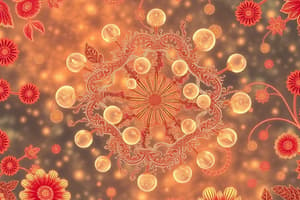Podcast
Questions and Answers
Where does glycolysis occur in the cell?
Where does glycolysis occur in the cell?
- Cytoplasm (correct)
- Chloroplasts
- Mitochondria
- Nucleus
What is the primary function of peroxisomes in the cell?
What is the primary function of peroxisomes in the cell?
- Produce energy-rich molecules
- Break down toxic compounds (correct)
- Store genetic material
- Synthesize proteins
Which organelle is responsible for photosynthesis?
Which organelle is responsible for photosynthesis?
- Chloroplasts (correct)
- Mitochondria
- Endoplasmic reticulum
- Peroxisomes
What is the main product of the Citric Acid (Krebs) Cycle or Electron Transport Chain?
What is the main product of the Citric Acid (Krebs) Cycle or Electron Transport Chain?
Cells adhere to one another through which process?
Cells adhere to one another through which process?
Where does the Electron Transport Chain take place in the cell?
Where does the Electron Transport Chain take place in the cell?
Which organelle is known as the powerhouse of the cell?
Which organelle is known as the powerhouse of the cell?
What is the main function of the Golgi Apparatus in a cell?
What is the main function of the Golgi Apparatus in a cell?
Which organelle contains digestive enzymes to break down waste materials within the cell?
Which organelle contains digestive enzymes to break down waste materials within the cell?
What is the function of the Endoplasmic Reticulum (ER) in a cell?
What is the function of the Endoplasmic Reticulum (ER) in a cell?
Which organelle organizes microtubules that form part of the cell's cytoskeleton?
Which organelle organizes microtubules that form part of the cell's cytoskeleton?
What is the role of the Nucleus in a cell?
What is the role of the Nucleus in a cell?
Study Notes
Understanding Cells: Structure, Function, and Processes
Cells, the fundamental units of life, are complex and diverse, yet they all share a common blueprint. In this exploration, we'll delve into cellular structure, function, and the processes that enable life, starting with cell organelles and their role in cellular respiration.
Cellular Structure: Organelles and Their Functions
Cells contain a variety of specialized structures called organelles, each with specific functions that contribute to the overall operations of the cell. Some main organelles include:
- Nucleus: The control center of the cell, containing DNA and regulating genetic expression.
- Mitochondria: The powerhouses of the cell, responsible for cellular respiration and energy production.
- Endoplasmic Reticulum (ER): A network of membranes involved in protein synthesis, lipid production, and calcium storage.
- Rough ER: Studded with ribosomes for protein synthesis.
- Smooth ER: Lacks ribosomes and is involved in lipid synthesis.
- Golgi Apparatus: Packages and modifies proteins and lipids synthesized in the ER and prepares them for cellular use.
- Centrosome/Microtubule Organizing Center (MTOC): Organizes microtubules that form part of the cell's cytoskeleton and play a role in cell division.
- Lysosomes: Contain digestive enzymes and help break down waste materials within the cell.
- Peroxisomes: Small organelles containing enzymes that break down toxic compounds and produce energy-rich molecules.
- Chloroplasts: Present only in plant cells, they are the sites of photosynthesis.
Cellular Respiration and Energy Production
Cellular respiration is the process by which cells convert biochemical energy from nutrients into a form that the cell can use, primarily ATP (adenosine triphosphate). This crucial process takes place in mitochondria.
- Glycolysis: Occurs in the cytoplasm and breaks down glucose into pyruvate, producing ATP and NADH (nicotinamide adenine dinucleotide).
- Citric Acid (Krebs) Cycle or Electron Transport Chain: Occurs in the inner mitochondrial membrane and breaks down pyruvate, producing ATP, carbon dioxide, and NADH.
- Electron Transport Chain: Also in the inner mitochondrial membrane, uses NADH to generate ATP through a series of redox reactions.
Cell Function and Communication
Cells function as independent units but often interact with one another to form tissues, organs, and organ systems, helping to maintain homeostasis. They achieve this through various processes:
- Signal transduction: Cells receive signals from their environment and transmit them internally to regulate cellular processes.
- Cell adhesion: Cells adhere to one another, forming a coherent tissue.
- Cell migration: Cells move from one location to another within the body.
- Cell division: Cells increase in number through mitosis and meiosis.
Cells are truly the building blocks of life. Understanding their structure, function, and processes provides a foundation for comprehending the complexities of biology, from single-celled organisms to multicellular organisms. This knowledge is essential for understanding diseases, development, and maintaining health.
Studying That Suits You
Use AI to generate personalized quizzes and flashcards to suit your learning preferences.
Description
Test your knowledge on cellular structure, organelles, cellular respiration, energy production, and cell function and communication. Explore the roles of organelles like the nucleus, mitochondria, and ER, the process of cellular respiration in mitochondria, and how cells communicate and function collectively in organisms.




